Click above for a high-res gallery of the 2008 Shelby GT500 Mustang
Sometime around late 2003, I first saw the car that was at that time still known as Condor. Condor was the Ford internal code name for the SVT version of the yet to be publicly shown S197 Mustang. At that time, most everyone outside of Ford was still anticipating that this car would be the new Mustang Cobra. Somewhere along the line to launch, Ford had settled its long standing conflict with Carroll Shelby and Condor ended up wearing one of the other classic Mustang badges from the '60s. The Shelby GT500 eventually started rolling off the Flat Rock, MI assembly line in both coupe and convertible forms for the 2007 model year.
Ford recently dropped off a Grey 2008 GT500 coupe at the Autoblog Garage for a few days, and we just had to share. By coincidence, the GT500 arrived about three weeks after the Mustang Bullitt we reviewed. While the Bullitt was about as understated as a modern Mustang can get, the GT500 is anything but. The Shelby is slathered in stripes, badges, spoilers and driving lights. The GT500 also has a very different powertrain from the Bullitt. Find out how the GT500 compares to the stealth 'Stang after the jump.
Photos Copyright ©2008 Sam Abuelsamid / Weblogs, Inc.
click any image to enlarge
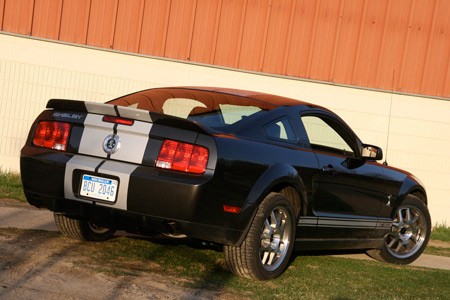
As I said before, the GT500 is the anti-Bullitt. Under the bulging hood, the 4.6L SOHC V8 has been replaced by a 5.4L dual overhead camshaft V-8 with a supercharger sitting in the valley between the banks. If that spec sounds familiar, that's because so far it matches the plant from the now discontinued Ford GT. However, the engine in this super pony is quite a bit different. The GT used an aluminum block with dry sump lubrication. Unfortunately, the dry sump configuration couldn't be packaged in the Mustang so Ford swapped in the wet sump 5.4L block used in the F-150. The bad news is that the truck block is cast from iron rather than lighter weight aluminum.
The downside of the new block is a significant weight penalty. The GT500 carries about 550 lbs more mass than a regular GT, with most of it over the front axle. Of course, not all of that is due to the engine. Some comes from additional equipment installed in the Shelby. The GT500 weighs in at a porky 3,920 pounds with the balance shifting from the GT's 54/46 to a more nose heavy 57/43.
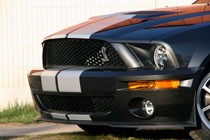
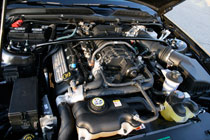
While the iron block is different from the GT, the aluminum cylinder heads were retained from the super-car. With the 8.5 psi of pressure in addition to atmospheric pressure, the 5.4L V8 churns out 500 hp at 6,000 rpm and 480 lb-ft of torque at 4,500 rpm, making this by far the most powerful series production Mustang built to date. There are some even more limited production variants coming like the GT500KR and the Super Snake (Ford spokesman Alan Hall reminded me that the Super Snake is not actually a factory authorized package but is in fact post title and sold by Shelby Automobiles), but those are more like factory authorized tuner specials. What is particularly impressive is that Ford is able to make this much power while meeting all of today's emissions standards. Unlike engines from the '60s, Shelbys these days idle smoothly at a nice steady 600 rpm, never failing to start or suffering from vapor lock on hot summer days.

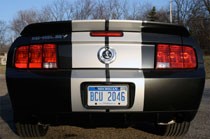
Transferring all that power and torque to the rear axle is handled by a Tremec TR6060 six-speed gearbox. That makes this the only non-five-speed gearbox in the current Mustang lineup. At the other end of the prop-shaft sits a live axle with the same three-link and Panhard rod setup as every other S197 Mustang. When the GT500 was first revealed in early 2005, many fans were appalled that the independent rear suspension of the previous generation Cobra would no longer be available on the most powerful Mustang. Seems like most are learning to live with it.
Let's go back to that first red Condor prototype I saw back in late 2003. When I saw it, the car was up on a hoist and the rear end was clearly visible. At that time, there was an IRS installed in the car. That was the last time I saw a Condor with IRS. All subsequent examples reverted to the live axle and the IRS prototypes were also retrofitted. Why did Ford seemingly go backwards? Cost, weight and performance are the likely culprits. Too much of the first two and not enough of the latter. For the most part, the live axle configuration of the S197 is among the best of it's type ever created. For a relatively simple hardware configuration, Ford engineers did a great job sorting this one out. That's not to say it's perfect. There are limits and the GT500 does exhibit some axle tramp under maximum acceleration.

Speaking of acceleration, the GT500 has plenty of it, although surprisingly not that much more than the Bullitt. While the super 'Stang has a 185 hp and 155 lb-ft advantage over the Bullitt, all that extra mass and tire-limited traction mean that it is only marginally quicker on the road. While the GT500 is undoubtedly fast, it doesn't really feel much stronger. Those extra 550 lbs feel ever present and the increased weight over the front axle only makes things worse. Even the clutch and shift effort feel marginally heavier than the Bullitt.
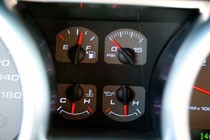
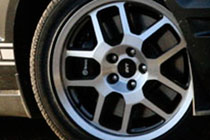
The seats, thick leather-covered steering wheel and dash covering are all shared with the Bullitt as well, though the metal trim panel is absent in the Shelby. The oil temperature gauge is also supplanted by a boost gauge in the GT500. One negative effect of the visual "enhancements" applied to the GT500 is reduced visibility to the rear. The spoiler on the rear deck cuts a surprising amount from the view through the rear window.
The fastest way to launch a GT500 is to bring the tach up to 3,500 rpm and drop the clutch and then get ready to shift before the engine bounces off the rev-limiter. I didn't do that with this particular example because I didn't have the opportunity to take it to the track and Ford asked us not to shred the tires too much. On the move, squeezing the "go" pedal hard brings up a hellacious wail from the Roots-type blower as the tach needle sweeps around to the red-line. The combined blower whine and exhaust roar make for quite a symphony, but frankly I preferred the sound of the Bullitt with its more classic, naturally aspirated note.
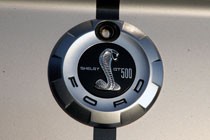
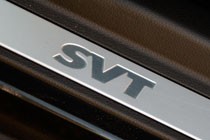
When it comes to changing direction, all the extra mass of the Shelby gives it a somewhat leaden feeling, especially compared to the Bullitt. The springs are stiffer in order to support the extra weight and that has a deleterious affect on the ride quality. In real world driving, the Shelby feels far less nimble and downright less pleasurable to drive. Braking, too, is another mixed bag. At the front corners, the GT500 gets Brembo-sourced 14-inch rotors and four-pot calipers. The stiff Italian calipers provide fantastic pedal feel, but again, the extra stopping power is at least partly consumed by the added weight.
Is the GT500 worth $10,000 or more than a Bullitt or any other well-equipped GT? It depends on whether you want the bragging rights of having the most bad-ass Mustang. One possibility that the GT500 offers not available with the Bullitt is a convertible. On the other hand, you can always get a GT convertible for even less. For my money, I'd choose the Bullitt and pocket the extra 10 grand to help pay for ever more expensive gas. The GT500 is marginally quicker, but not in any way you can use in everyday driving. The Bullitt is just plain easier to live with as a daily driver.
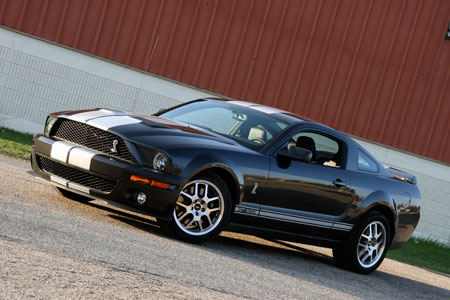
Photos Copyright ©2008 Sam Abuelsamid / Weblogs, Inc.


Sign in to post
Please sign in to leave a comment.
Continue